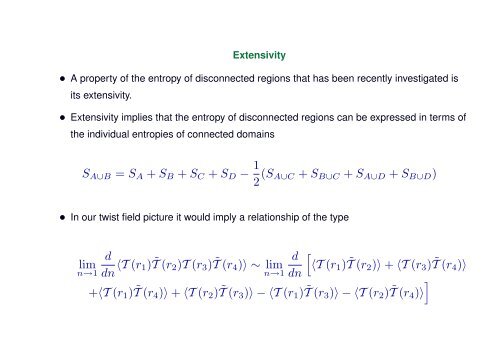entanglement entropy of disconnected regions - Staff.city.ac.uk - City ...
entanglement entropy of disconnected regions - Staff.city.ac.uk - City ... entanglement entropy of disconnected regions - Staff.city.ac.uk - City ...
The entropy of disconnected regions from twist fields • Similarly to the previous case, the partition function of the n-sheeted Riemann surface can be expressed in terms of a correlation function of twist fields. In this case it is a four point function: 〈T (r 1 ) ˜T (r 2 )T (r 3 ) ˜T (r 4 )〉 L (n) ∫ [ ∫ ] ∝ [dϕ 1 · · · dϕ n ] R 2 exp − d 2 x L (n) [ϕ 1 , . . . , ϕ n ](x) C 0,r R 2 = Z n = Tr A∪B (ρ n A∪B) • From a computational point of view, it is much more challenging to compute a four-point function than a two-point function, even in the two-particle approximation. • Some limiting cases, such as r 1,2 ≪ r 3,4 can be analyzed more easily.
Extensivity • A property of the entropy of disconnected regions that has been recently investigated is its extensivity. • Extensivity implies that the entropy of disconnected regions can be expressed in terms of the individual entropies of connected domains S A∪B = S A + S B + S C + S D − 1 2 (S A∪C + S B∪C + S A∪D + S B∪D ) • In our twist field picture it would imply a relationship of the type d dn 〈T (r 1) ˜T (r 2 )T (r 3 ) ˜T d [ (r 4 )〉 ∼ lim 〈T (r 1 ) n→1 dn ˜T (r 2 )〉 + 〈T (r 3 ) ˜T (r 4 )〉 +〈T (r 1 ) ˜T (r 4 )〉 + 〈T (r 2 ) ˜T (r 3 )〉 − 〈T (r 1 ) ˜T (r 3 )〉 − 〈T (r 2 ) ˜T ] (r 4 )〉 lim n→1
- Page 1: Entanglement entropy in 1+1 dimensi
- Page 4 and 5: How and why to measure (or quantify
- Page 6 and 7: - The maximally entangled state |gs
- Page 8 and 9: Short- and large-distance entanglem
- Page 10 and 11: Partition functions on multi-sheete
- Page 12 and 13: • Another twist field ˜T is asso
- Page 14 and 15: Hence we have Short- and large-dist
- Page 16 and 17: The entropy of disconnected regions
- Page 20 and 21: Some simple limit cases • When r
- Page 22 and 23: Non-extensivity • In recent years
Extensivity<br />
• A property <strong>of</strong> the <strong>entropy</strong> <strong>of</strong> <strong>disconnected</strong> <strong>regions</strong> that has been recently investigated is<br />
its extensivity.<br />
• Extensivity implies that the <strong>entropy</strong> <strong>of</strong> <strong>disconnected</strong> <strong>regions</strong> can be expressed in terms <strong>of</strong><br />
the individual entropies <strong>of</strong> connected domains<br />
S A∪B = S A + S B + S C + S D − 1 2 (S A∪C + S B∪C + S A∪D + S B∪D )<br />
• In our twist field picture it would imply a relationship <strong>of</strong> the type<br />
d<br />
dn 〈T (r 1) ˜T (r 2 )T (r 3 ) ˜T d<br />
[<br />
(r 4 )〉 ∼ lim 〈T (r 1 )<br />
n→1 dn<br />
˜T (r 2 )〉 + 〈T (r 3 ) ˜T (r 4 )〉<br />
+〈T (r 1 ) ˜T (r 4 )〉 + 〈T (r 2 ) ˜T (r 3 )〉 − 〈T (r 1 ) ˜T (r 3 )〉 − 〈T (r 2 ) ˜T<br />
]<br />
(r 4 )〉<br />
lim<br />
n→1



